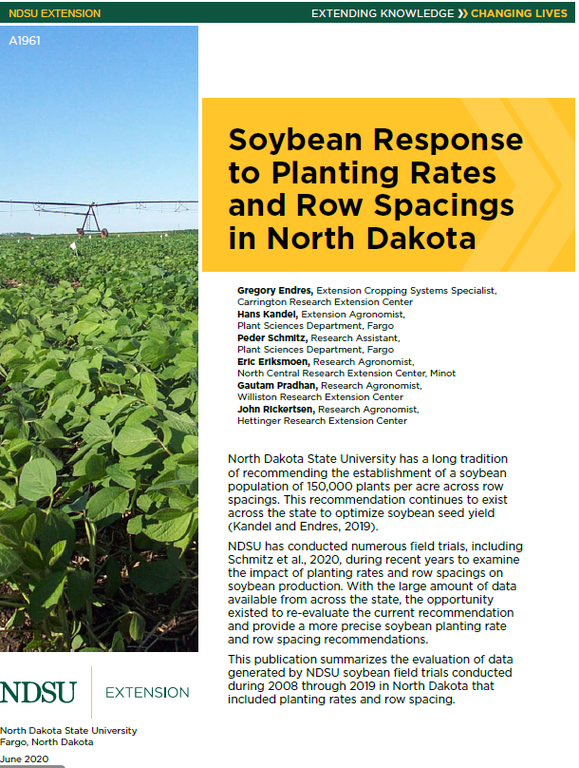Soybean Yield Response to Planting Rates and Row Spacings in North Dakota
North Dakota State University has been conducting field research on soybean planting rates and/or row spacing for decades. NDSU also has had the long-term recommendation for soybean plant stand of 150,000 plants per acre across row spacings. In 2020, data was compiled and evaluated from 37 NDSU trials conducted during 2008 through 2019 across the state. The objective was to provide a more precise guide for establishing soybean stands, using seed yield response data among regions in the state, based on the combination of planting rates and row spacings. This work resulted in publishing the NDSU Extension circular A1961 ‘Soybean response to planting rates and row spacings in North Dakota’.
The following is a summary of the research data:
Individual factors
- Across North Dakota and row spacings, the planting rate of about 170,00 pure live seeds (PLS) per acre optimized soybean seed yield. In eastern North Dakota trials, 8% of planted PLS per acre did not develop into viable soybean plants. Assuming 8% of PLS does not result in established plants across North Dakota, and using 170,000 PLS per acre, about 155,000 plants per acre would be expected to maximize yield. Within regions, optimum yield occurred with 180,000 and about 140,000 PLS per acre in eastern and western North Dakota, respectively.
- Across North Dakota or by regions, narrow rows (less than 15 inches) consistently provided greatest soybean yield.
Factor combination (by regions)
- In eastern North Dakota, the combination of narrow rows (12 to 14 inches) and planting rates of about 170,000 PLS per acre provided optimum yield. If planting in wide rows (24 to 30 inches), planting rates to reach the optimum yield were about 190,000 PLS per acre.
- In western North Dakota, the combination of narrow rows (7 to 10 inches) and planting rates of about 150,000 PLS per acre provided optimum yield.
See table for estimated early season plant stands based on PLS per acre planting rates minus selected percentages of plants not established due to field loss.

Note the above planting rates are for optimum yield. Economic yield must also be considered based on seed costs.
Greg Endres
Extension Cropping Systems Specialist
Gregory.Endres@ndsu.edu
Hans Kandel
Extension Agronomist and Professor
Hans.Kandel@ndsu.edu



